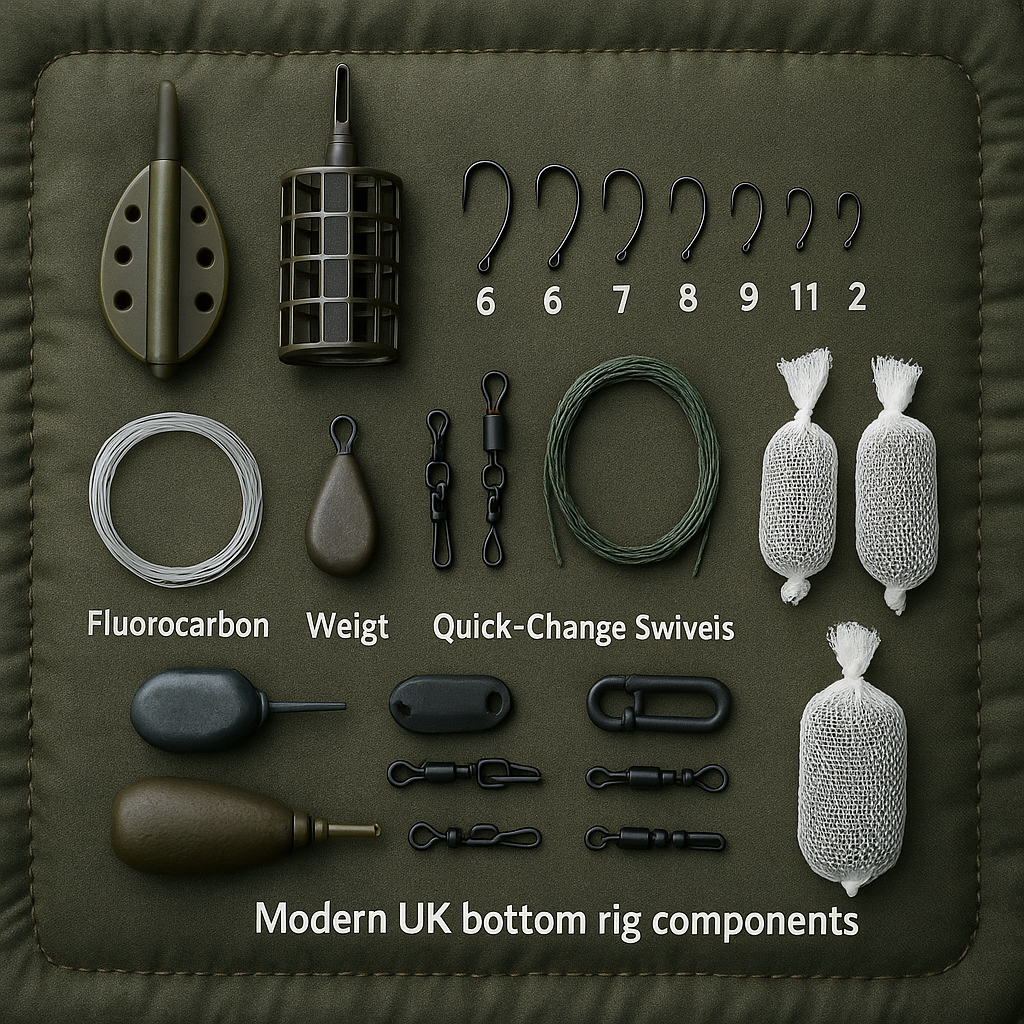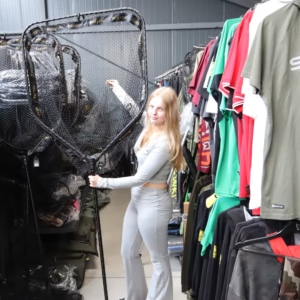A practical, UK-specific guide to building and fine-tuning feeder, hair, zig and PVA rigs for rivers, lakes and canals
Introduction
England’s coarse fishing scene presents unique challenges that demand precision-engineered rigs. Our pressured day-ticket carp lakes, winding canals and tidal rivers with fast, abrasive flows require tackle that can handle both wary fish and demanding conditions. The difference between a well-constructed bottom rig and a bodged setup can literally make or break your session.
Modern English angling has evolved far beyond the simple leger rig of decades past. Today’s successful anglers understand that presentation is everything, especially when targeting educated fish that have seen every bait under the sun. Whether you’re after a canal-bred roach that’s dodged a thousand maggots or a thirty-pound carp that’s been caught and released more times than it cares to remember, your rig needs to be absolutely spot-on.
The beauty of mastering bottom rigs lies in their versatility. A correctly-built rig performs three vital functions that can transform your catch rate. It presents the hook bait so naturally that even the most cautious fish will pick it up without suspicion. It delivers a precise micro-bed of feed exactly around the hook, which is absolutely critical on venues where you cannot pile in kilos of bait. Most importantly, it flags bites cleanly and safely under EA rules that prohibit fixed leads likely to tether fish.
Understanding UK Legal Requirements
Essential Licensing and Regulations
Before we dive into rig construction, every angler must understand the legal framework governing our sport. The Environment Agency takes compliance seriously, and ignorance is no defence when the bailiff appears on the bank.
| Topic | Key Rule | Penalty for Non-Compliance |
|---|---|---|
| Rod Licence | All anglers 13+ must hold valid EA licence | £2,500 fine + court costs |
| Close Season | Rivers off-limits 15 Mar – 15 Jun for coarse fish | £2,500 fine + prosecution |
| Lead Weights | Only < 0.06g dust shot OR > 28.35g leads legal | Confiscation + potential fine |
| Fish Care | Barbless/micro-barb hooks required on most commercials | Venue ban + potential prosecution |
The lead weight regulations catch out many anglers. That quarter-ounce pear lead sitting in your tackle box? It’s been illegal for years. The banned zone covers everything between 0.06g and 28.35g (1oz), forcing us to use either tiny dust shot or proper-sized leads. This actually works in our favour – tungsten alternatives cast straighter and cause less environmental damage.
Environmental Responsibilities
Modern angling demands environmental awareness. The close season exists for good reason – our coarse fish need undisturbed spawning time between 15 March and 15 June on rivers and streams. Most lakes and canals remain open, but check local bylaws as some venues impose additional restrictions.
Fish care standards have risen dramatically. An unhooking mat, antiseptic gel and proper landing net are no longer optional extras – they’re essential kit that any serious angler should consider standard equipment.
Core Components of Modern UK Bottom Rigs
Main Line Selection
Your main line choice depends entirely on the water you’re fishing. Fast-flowing rivers demand thin, low-stretch braid that cuts through the current and telegraphs the subtlest touches. A 0.12-0.16mm eight-strand braid paired with a 45cm shock leader gives you the sensitivity to detect a two-tap chub bite while providing the strength to turn a bolting barbel.
Still waters call for different tactics. Here, 0.22-0.26mm mono or 15lb sinking braid works better. Mono’s stretch cushions the lunges of a netted carp, while sinking braid maintains direct contact in deeper swims without creating a bow that spooks cruising fish.
Hook Link Construction
The hook link is where many rigs fail. Rivers require short, stiff connections – 10-15cm of quality fluorocarbon in 0.18-0.22mm keeps your bait pinned to the deck in strong currents. Fluorocarbon’s near-invisibility underwater and excellent abrasion resistance make it perfect for rocky or snaggy swims.
Still water presentations benefit from longer, more supple links. A 25-45cm soft-braid coated hooklink allows your bait to “hinge” away from the feeder naturally, creating that critical separation that fools wary fish into confident feeding.
Weight and Feeder Systems
| Water Type | Recommended Weight | Feeder Style | Key Benefit |
|---|---|---|---|
| Fast River | 60-100g grip lead | Flat-bottomed cage | Holds bottom in strong flow |
| Slow/Still Water | 30-60g method feeder | In-line flatbed | Accurate bait delivery |
| Canal/Narrow Water | 20-40g bomb | Swivel-attached | Minimal disturbance |
The golden rule is simple: use enough weight to keep your rig static without burying it in soft silt. A feeder that disappears into the lakebed is useless – it needs to sit proud, creating an attractive feeding area that draws fish in from the surrounding area.
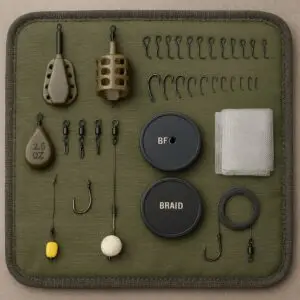
Rig Selection for Different English Venues
Method Feeder Rigs
Method feeders have revolutionised carp fishing on English commercials. The in-line design creates a devastating combination of attraction and presentation that accounts for countless big fish each season.
Optimal Conditions: Commercial carp lakes, natural still waters up to 4 metres deep, lightly flowing lower Severn and Trent sections during low water periods.
Construction Process: Start by sliding an in-line flatbed feeder (30-60g depending on casting distance) onto your main line. Add a tail rubber sleeve and size-8 quick-change swivel for easy hooklink swaps. Clip on a 10cm supple braid hair-link armed with an 8-10mm wafter that perfectly balances just off the bottom.
The magic happens in the moulding. Use damp 2mm pellets crammed tightly around the feeder body. When this hits the deck concave-side up, it creates an irresistible feeding area. Carp home in on the micro-pile of food but encounter your balanced wafter first – a bait that looks like food but behaves differently enough to trigger an investigative take.

Hair Rig Systems
The hair rig remains the foundation of serious carp angling, but modern versions incorporate refinements that our pioneering predecessors could never have imagined.
Peak Performance Situations: Targeting wary carp and tench over beds of particles, presenting big boilies on gravel bars, or when fish have become suspicious of standard feeder presentations.
Advanced Construction: Begin with a knotless knot tying a size 6 curved-shank barbless hook to 25cm of quality fluorocarbon. Leave a precise 2cm hair and stop your chosen boilie with a dumbbell stop rather than traditional bait stops – they’re less conspicuous and more reliable.
Professional Upgrade: Thread a 2mm kicker sleeve over the hook shank. This simple addition rotates the hook 180 degrees on pickup, virtually guaranteeing clean bottom-lip hooking. Pair this setup with a 2½oz semi-fixed lead clip or, for maximum safety, a tungsten drop-off system that releases under extreme pressure.

Zig Rig Tactics
Summer fishing often demands thinking in three dimensions. When carp cruise mid-water during high-pressure afternoons, traditional bottom presentations become irrelevant.
Prime Conditions: Clear carp ponds and reservoirs during settled summer weather, particularly when fish are visibly active in the upper water layers.
Precision Building: Slide an inline 10-20g controller float onto your main line, followed by a buffer bead and swivel connection. Tie 1-3 metres of 9lb low-diameter mono to a size 10 barbless hook – the length depends on your target depth, typically 40-60% of total water depth.
Bait Presentation: Trim a sliver of black or yellow zig foam so it achieves neutral buoyancy at your chosen depth. The colour choice matters – black mimics natural debris while yellow provides high visibility. Pro tip: glue a tiny 6mm cork ball under the foam to prevent nuisance silver fish from pecking it apart.
PVA Bag Precision
When pinpoint feeding becomes critical, nothing beats a properly constructed PVA presentation. This technique excels in situations where loose feeding is restricted or counterproductive.
Tactical Applications: Winter “one bite” sessions when fish feeding is minimal, urban canals where competition from small fish is intense, or weedy estate lakes where scattered bait disappears into vegetation.
Expert Construction: Start with a short 12cm coated-braid hooklink armed with a 10mm pink fluorocarbon pop-up – the bright colour provides crucial visibility in coloured water. Fill a 60x130mm PVA mesh with a carefully balanced mix: 60% 2mm pellets for sustained attraction, 40% crushed krill boilie for instant impact, finished with a dusting of amino powder for scent trail.
Deployment Technique: Hook the bag on the point, nicking only the mesh lip to ensure it releases cleanly on impact. Cast gently to avoid bag bursting – the whole system dissolves in 40-60 seconds even in 6°C water, creating a softball-sized feeding area perfectly positioned around your hook bait.
Strategic Rig Selection Guide
Choosing the right rig for conditions separates successful anglers from those who struggle. This decision tree approach eliminates guesswork and maximises your chances from the first cast.
Primary Considerations
Water Movement Assessment: If water moves faster than walking pace, you need river tactics – flat-bottomed feeders or grip leads with short fluorocarbon links. Anything else will roll or lift, destroying your presentation.
Fish Behaviour Observation: When fish are visible cruising mid-column, particularly during bright conditions, zig rigs at 40-60% of total depth consistently outperform bottom presentations.
Venue Restrictions: Many commercials ban loose-feed spods and spombs. In these situations, PVA bags or in-line method feeders become your only legal feeding options.
Temperature Considerations: Water below 10°C demands subtle presentations. Quarter-fill your PVA bags, use single bright hook baits, and minimise loose feed to match the fish’s reduced metabolism.
Seasonal Adaptations
Spring Tactics: As fish emerge from winter lethargy, small PVA bags with high-attract baits work better than large feed presentations. Fish are feeding but not competitively – subtlety wins.
Summer Strategies: High-pressure periods call for zig rigs and surface tactics. When fish refuse bottom baits, presenting at their feeding level transforms difficult sessions.
Autumn Approaches: As fish prepare for winter, larger method feeder presentations loaded with high-protein pellets match their increased feeding activity.
Winter Precision: Single hook baits over minimal loose feed. Fish conserve energy – your presentation must be worth their effort to investigate.
Performance-Enhancing Techniques
Advanced Rig Testing
Water Bucket Verification: Before every session, test your rig setup in a water bucket. Cast the complete system in – if it tangles, it will tangle on the lakebed. This simple check prevents countless lost opportunities.
Strip and Hinge Method: Peel the last 3cm of coating from braid hooklinks. This creates a flexible hinge point that allows your bait to flip away from the feeder naturally, triggering more confident takes.
Casting and Positioning Accuracy
Marker Elastic Technique: Wind marker elastic around your spool at the exact distance of your target area. This allows dead-accurate recasting to productive spots without constant measuring or guesswork.
Progressive Casting: Start with shorter casts and gradually work out to your target range. This builds accuracy and prevents the disappointment of overcasting a carefully-prepared swim.
Equipment Maintenance Standards
Hook Point Discipline: Touch-stone hone or change hooks every three fish or after any snag contact. A blunt hook point costs more fish than any other tackle failure.
Lead Safety Compliance: Replace any banned lead weights with tungsten putty alternatives. They’re legal, environmentally responsible, and often provide better presentation than traditional leads.
Watercraft Applications
Feeder Flavour Rotation: Systematically cycle through krill, sweetcorn, and garlic flavours every three casts until you identify the day’s winner. Fish preferences change with conditions – stay adaptable.
Silent Bankside Approach: Rubber net meshing and EVA bucket bases eliminate the clonks and bangs that spook educated fish. Noise discipline often makes the difference between success and failure.
Step-by-Step River Feeder Construction
Building the perfect river feeder rig requires attention to detail at every stage. This system has accounted for countless barbel, chub and roach from England’s finest rivers.
Component Assembly
Main Line Connection: Join 0.14mm eight-strand braid to 0.26mm mono leader using an Albright knot. This combination provides sensitivity with casting safety and fish-playing security.
Anti-Tangle System: Create a 15cm twisted-loop boom from stiff mono, connecting to a quick-change swivel. This boom prevents tangles during casting and allows rapid hooklink changes.
Feeder Selection: Clip a flat 80g cage feeder to the swivel, ensuring the tail rubber covers the knot connection. Flat-bottomed designs grip the river bed better than round alternatives.
Hook Link Preparation: Tie 12cm of fluorocarbon to a size 12 wide-gape hook, adding a maggot clip for secure bait presentation. Short links keep baits tight to the bottom in flowing water.
Loading and Deployment
Feed Mixture: Combine 60% hemp with 40% micro pellets, finished with a dusting of black roasted groundbait. This blend provides sustained attraction without overfeeding.
Casting Technique: Cast upstream at 30 degrees and allow the rig to swing into position. Keep the rod tip low with braid tight – this setup telegraphs the characteristic two-tap chub bite perfectly.
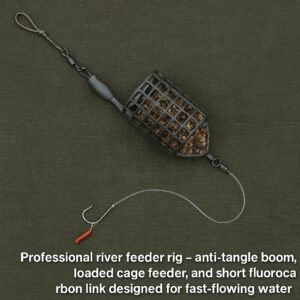
Fine-Tuning for Conditions
Flow Adjustment: In heavy flow, increase feeder weight rather than shortening the hooklink. Maintain that critical bait separation while ensuring the rig holds position.
Bait Selection: Match bait size to target species and conditions. Single maggots for roach, double for chub, and worms for barbel. Let the fish tell you what they want.
Troubleshooting Common Problems
Bite Detection Issues
Missed Bites: Usually caused by too much slack line or incorrect rod positioning. Keep a tight line to the feeder but don’t strike at every tiny tremor – learn to read your particular setup.
False Indications: Often result from loose connections or incorrect feeder weight. Everything must be tight and properly balanced for clean bite registration.
Presentation Failures
Tangles on Casting: Nearly always caused by components that don’t match – stiff hooklinks with soft main lines, or incorrect boom lengths. Test everything in controlled conditions first.
Bait Not Reaching Fish: Check your casting accuracy and feeder positioning. A rig that works perfectly can fail completely if placed in the wrong spot.
Equipment Reliability
Hook Link Failure: Usually occurs at knot connections under strain. Practice your knots until they’re perfect – a failed knot costs fish and terminal tackle.
Feeder Problems: Blocked mesh reduces attraction and effectiveness. Clean feeders thoroughly after every session, especially when using sticky groundbaits.
Seasonal Rig Adaptations
Spring Transitions
As water temperatures rise and fish become more active, your rig selection needs to match changing behaviour patterns. Early spring still demands subtle presentations, but by late spring you can increase bait size and feeding levels.
Temperature Triggers: Water reaching 8-10°C marks the transition from winter to spring tactics. Monitor temperature trends rather than relying on calendar dates.
Feeding Response: Spring fish are cautious but increasingly competitive. Gradually increase your loose feeding as sessions progress and fish confidence builds.
Summer Maximisation
High summer presents both opportunities and challenges. Fish are active but pressured, demanding refined presentations that outsmart educated quarry.
Pressure Tactics: When conventional bottom rigs fail, switch to zig presentations or surface tactics. Fish feeding levels change with barometric pressure – adapt accordingly.
Heat Wave Strategies: During prolonged hot spells, focus on dawn and dusk sessions when fish are most active. Midday zig fishing can produce when nothing else works.
Autumn Opportunities
Autumn fishing often provides the year’s best opportunities as fish prepare for winter. Larger baits and increased feeding levels match their enhanced appetite.
Pre-Winter Feeding: Fish actively build reserves before winter dormancy. This is the time for maximum attraction – larger method feeders, more loose feed, higher protein baits.
Weather Windows: Settled autumn weather often produces exceptional fishing. Plan sessions around stable high-pressure periods for best results.
Winter Precision
Winter fishing demands the highest levels of precision and patience. Every element of your presentation must be perfect to tempt lethargic fish.
Minimal Disturbance: Use the smallest effective presentations. Single hook baits over tiny amounts of loose feed often outperform elaborate rigs.
Bite Recognition: Winter bites are often subtle – small movements of the rod tip or slight line tremors. Develop sensitivity to minimal indications.
Advanced Watercraft Integration
Reading Water Conditions
Understanding your venue’s unique characteristics allows tactical rig selection that maximises effectiveness in specific conditions.
Flow Patterns: Learn how your chosen venues flow in different conditions. Spring floods, summer low water, and autumn rain all create different opportunities requiring adapted approaches.
Seasonal Variations: The same swim can require completely different tactics throughout the year. Build a mental database of what works when and where.
Fish Behaviour Interpretation
Feeding Signals: Learn to read the signs – rolling fish, bubbling areas, disturbed silt clouds. Each tells you something about fish location and mood.
Pressure Response: Understand how your target fish respond to angling pressure. Some become more cautious, others simply move location.
Maximising Success Rates
Session Planning
Pre-Session Preparation: Check weather forecasts, water levels, and recent catch reports. Arrive with a clear tactical plan based on current conditions.
Rig Selection Strategy: Carry pre-tied rigs for different scenarios. Quick changes during sessions can transform difficult periods into productive ones.
Adaptive Tactics
Response Flexibility: Be prepared to change tactics completely if initial approaches fail. Rigid adherence to predetermined plans often results in blank sessions.
Learning Opportunities: Every session provides learning opportunities. Keep detailed records of successful tactics and conditions for future reference.
Summary and Next Steps
Mastering bottom rigs for English waters requires understanding the unique challenges our venues present. Legal compliance, environmental responsibility, and tactical flexibility form the foundation of consistent success.
Your rig selection must match venue characteristics, fish behaviour, and current conditions. A method feeder that devastates commercial carp may fail completely on a fast-flowing river, while a delicate canal rig would disappear in strong currents.
Essential Principles:
- Match rig type to venue flow, depth and feeding restrictions
- Maintain legal compliance with EA licensing and tackle regulations
- Keep hook points surgically sharp and log every session for pattern recognition
- Develop the flexibility to change tactics when conditions demand
Practical Challenge: On your next outing, pack three pre-tied hooklinks – 10cm, 25cm, and 45cm lengths. Swap them methodically every 30 minutes and note which converts the first definitive bite. This systematic approach reveals preferences you might otherwise miss.
The best anglers never stop learning and adapting. Share your findings and catch photos in angling forums – the collective knowledge of our angling community benefits everyone. What works on your local venue might unlock success for fellow anglers facing similar challenges.
Modern bottom rig fishing combines traditional watercraft with contemporary tackle technology. Master both elements and you’ll find success on even the most challenging English waters.
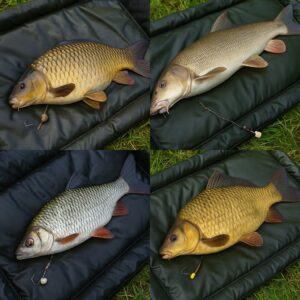
Tight lines and see you on the bank!

